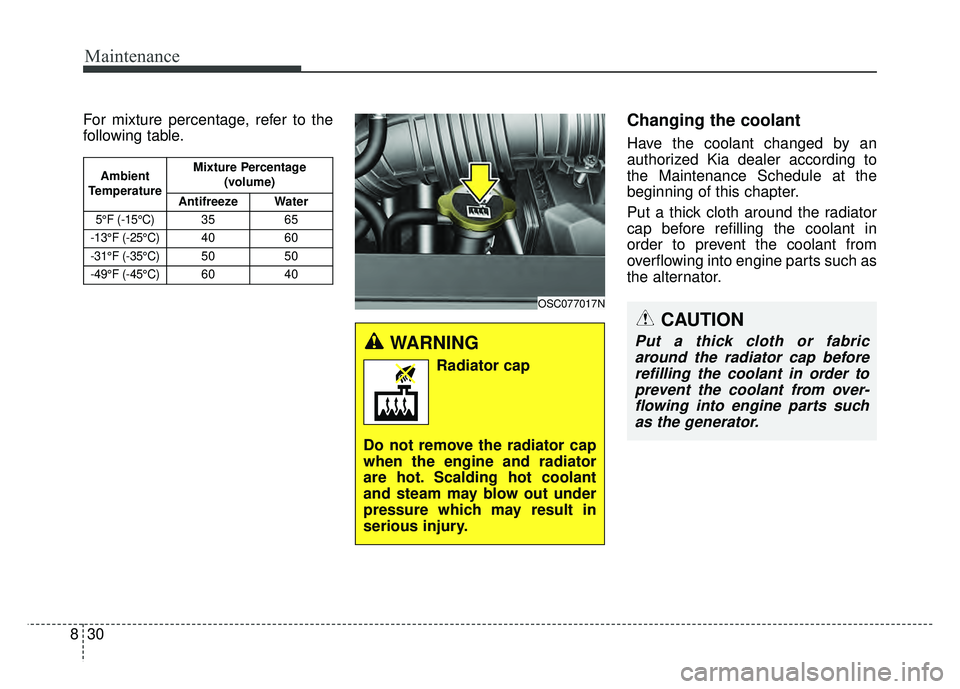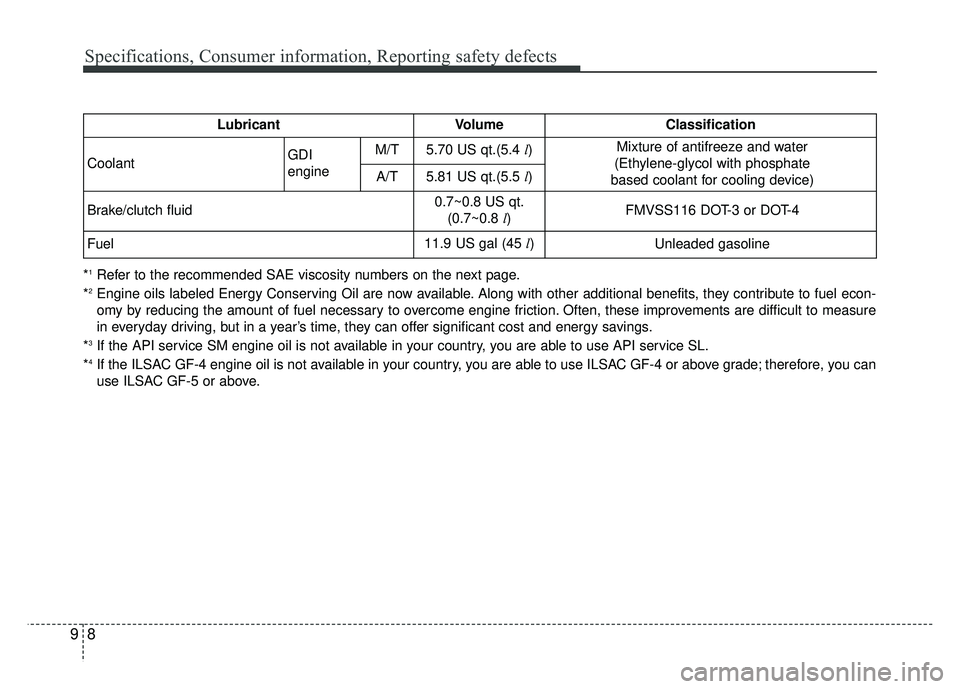2018 KIA RIO HATCHBACK engine coolant
[x] Cancel search: engine coolantPage 378 of 492

Maintenance
28
8
ENGINE COOLANT
The high-pressure cooling system
has a reservoir filled with year round
antifreeze coolant. The reservoir is
filled at the factory.
Check the antifreeze protection and
coolant level at least once a year: at
the beginning of the winter season,
and before traveling to a colder cli-
mate.Checking the coolant level Turn the engine off and wait until it
cools down. Use extreme care
when removing the radiator cap.
Wrap a thick towel around it, and
turn it counterclockwise slowly to
the first stop. Step back while the
pressure is released from the cool-
ing system.
When you are sure all the pressure
has been released, press down on
the cap, using a thick towel, and
continue turning counterclockwise
to remove it.
Even if the engine is not operating, do not remove the radiator cap or
the drain plug while the engine and
radiator are hot. Hot coolant and
steam may still blow out under
pressure, causing serious injury.
WARNING
Removing radiator
cap
Never attempt to remove the
radiator cap while the engine is
operating or hot. Doing so
might lead to cooling system
and engine damage and could
result in serious personal injury
from escaping hot coolant or
steam.
CAUTION - Radiator cap
Never attempt to remove the radiator cap while the engine isoperating or hot. Doing somight lead to cooling systemand engine damage.
Page 379 of 492

829
Maintenance
Check the condition and connections
of all cooling system hoses and
heater hoses. Replace any swollen
or deteriorated hoses.
The coolant level should be filled
between F and L marks on the side
of the coolant reservoir when the
engine is cool.
If the coolant level is low, add enough
specified coolant to provide protec-
tion against freezing and corrosion.
Bring the level to F, but do not over-
fill. If frequent additions are required,
see an authorized Kia dealer for a
cooling system inspection.
Recommended engine coolant
When adding coolant, use onlydeionized water or soft water for
your vehicle and never mix hard
water in the coolant filled at the fac-
tory. An improper coolant mixture
can result in serious malfunction or
engine damage.
The engine in your vehicle has alu- minum engine parts and must be
protected by an ethylene-glycol
with phosphate based coolant to
prevent corrosion and freezing.
DO NOT USE alcohol or methanol coolant or mix them with the spec-
ified coolant.
Do not use a solution that contains more than 60% antifreeze or less
than 35% antifreeze. This would
reduce the effectiveness of the
solution.
OSC077016N
WARNING- Cooling fan
Use caution when
working near the
blade of the cooling
fan. The electric
motor (cooling fan) is
controlled by engine coolant
temperature, refrigerant pres-
sure and vehicle speed. it may
sometimes operate even when
the engine is not running.
Page 380 of 492

Maintenance
30
8
For mixture percentage, refer to the
following table.Changing the coolant
Have the coolant changed by an
authorized Kia dealer according to
the Maintenance Schedule at the
beginning of this chapter.
Put a thick cloth around the radiator
cap before refilling the coolant in
order to prevent the coolant from
overflowing into engine parts such as
the alternator.
OSC077017N
Ambient
Temperature Mixture Percentage
(volume)
Antifreeze Water
5°F (-15°C)35 65
-13°F (-25°C)4060
-31°F (-35°C)5050
-49°F (-45°C)6040
WARNING
Radiator cap
Do not remove the radiator cap
when the engine and radiator
are hot. Scalding hot coolant
and steam may blow out under
pressure which may result in
serious injury.
CAUTION
Put a thick cloth or fabric around the radiator cap beforerefilling the coolant in order toprevent the coolant from over-flowing into engine parts suchas the generator.
Page 460 of 492

Maintenance
110
8
Canister
Fuel vapors generated inside the fuel
tank are absorbed and stored in the
onboard canister. When the engine is
running, the fuel vapors absorbed in
the canister are drawn into the surge
tank through the purge control sole-
noid valve.
Purge Control Solenoid Valve
(PCSV)
The purge control solenoid valve is
controlled by the Engine Control
Module (ECM); when the engine
coolant temperature is low during
idling, the PCSV closes so that evap-
orated fuel is not taken into the
engine. After the engine warms up
during ordinary driving, the PCSV
opens to introduce evaporated fuel to
the engine.
3. Exhaust emission control system
The Exhaust Emission Control
System is a highly effective system
which controls exhaust emissions
while maintaining good vehicle per-
formance.
Vehicle modifications
This vehicle should not be modified.
Modification of your vehicle could
affect its performance, safety or
durability and may even violate gov-
ernmental safety and emissions reg-
ulations.
In addition, damage or performance
problems resulting from any modifi-
cation may not be covered under
warranty.
If you use unauthorized electronic
devices, it may cause the vehicle to
operate abnormally, wire damage,
battery discharge and fire. For your
safety, do not use unauthorized
electronic devices.
Engine exhaust gas precautions
(carbon monoxide)
Carbon monoxide can be present with other exhaust fumes.
Therefore, if you smell exhaust
fumes of any kind inside your vehi-
cle, have it inspected and repaired
immediately. If you ever suspect
exhaust fumes are coming into
your vehicle, drive it only with all
the windows fully open. Have your
vehicle checked and repaired
immediately.
WARNING - Exhaust
Engine exhaust gases contain
carbon monoxide (CO). Though
colorless and odorless, it is
dangerous and could be lethal if
inhaled. Follow the instructions
on this page to avoid CO poi-
soning.
Page 470 of 492

Specifications, Consumer information, Reporting safety defects
89
*1Refer to the recommended SAE viscosity numbers on the next page.
*2Engine oils labeled Energy Conserving Oil are now available. Along with other additional benefits, they contribute to fuel econ-
omy by reducing the amount of fuel necessary to overcome engine friction. Often, these improvements are difficult to measure
in everyday driving, but in a year’s time, they can offer significant cost and energy savings.
*
3If the API service SM engine oil is not available in your country, you are able to use API service SL.
*4If the ILSAC GF-4 engine oil is not available in your country, you are able to use ILSAC GF-4 or above grade; therefore, you can
use ILSAC GF-5 or above.
LubricantVolumeClassification
Coolant GDI
engineM/T5.70 US qt.(5.4 l)Mixture of antifreeze and water
(Ethylene-glycol with phosphate
based coolant for cooling device)
A/T5.81 US qt.(5.5 l)
Brake/clutch fluid0.7~0.8 US qt. (0.7~0.8 l)FMVSS116 DOT-3 or DOT-4
Fuel11.9 US gal (45 l)Unleaded gasoline
Page 481 of 492

I3
Index
Battery........................................................................\
....8-42For best battery service ..............................................8-42
Recharging the battery ................................................8-43
Reset items ..................................................................8-44
Battery saver function ....................................................4-87
Battery saver function ....................................................4-87
Before driving ..................................................................6-4
Bonnet see the hood ......................................................4-36
Brake system..................................................................6-23 Parking brake ..............................................................6-25
Anti-lock brake system (ABS)....................................6-27
Electronic stability control (ESC) ..............................6-29
Vehicle stability management (VSM) ........................6-34
Hill-start assist control (HAC) ....................................6-33
Brake/clutch fluid ..........................................................8-31 Checking the brake/clutch fluid level ........................8-31
Bulb replacement ..........................................................8-75
Bulb replacement precaution ........................................8-75
Bulb wattage ....................................................................9-3
California Perchlorate notice ......................................8-112
Camera (Rear view) ......................................................4-86
Capacities (Lubricants) ....................................................9-7
Care Care of seat belts ........................................................3-22
Tire care ......................................................................8-\
45 Exterior care ..............................................................8-101
Interior care ..............................................................8-106
Center console storage ................................................4-128
Central door lock switch................................................4-18
Checking fluid levels ....................................................8-25
Checking tire inflation pressure ....................................8-46
Child restraint system ....................................................3-23 Placing a passenger seat belt into the auto lock mode .. 3-25
Securing a child restraint seat with child seat lower anchor system ..........................................................3-28
Securing a child restraint seat with tether anchorage system ......................................................................3-\
27
Child-protector rear door lock ......................................4-20
Climate control air filter ................................................8-36 Filter inspection ..........................................................8-36
Clothes hanger ............................................................4-135
Combined instrument, see instrument cluster ..............4-52
Consumer assistance (U.S. ONLY) ..............................9-12
Coolant ........................................................................\
..8-28
Cooling fluid, see engine coolant ..................................8-28
Covering shelf ..............................................................4-137
Crankcase emission control system ............................8-109
Cruise control system ....................................................6-48 Cruise control switch ..................................................6-48
To set cruise control speed..........................................6-49
To increase cruise control set speed ..........................6-50
To decrease the cruising speed ..................................6-50
To temporarily accelerate with the cruise control on ..6-50
C
Page 482 of 492

Index
4I
To cancel cruise control ..............................................6-51
To resume cruising speed at more than approximately 20 mph (3 0km/h) ....................................................6-51
To turn cruise control off ............................................6-52
Cup holder ..................................................................4-131
Curtain air bag ..............................................................3-48
Dashboard illumination, see instrument panel illumination..................................................................4-53
Dashboard, see instrument cluster ................................4-52
Day/night rearview mirror ............................................4-49
Declaration of Conformity ............................................5-39
Defogging (Windshield) ..............................................4-123
Defroster (Rear window) ............................................4-103
Defrosting (Windshield) ..............................................4-123
Dimensions ......................................................................9-\
2
Display illumination, see instrument panel illumination ..4-53
Displays, see instrument cluster ....................................4-52
Door locks......................................................................4-\
17 from outside the vehicle..............................................4-17
from inside the vehicle................................................4-18
Central door lock switch ............................................4-18
Child-protector rear door lock ....................................4-20
Driver's and passenger's front air bag ............................3-44
Driving at night ..............................................................6-58
Driving in flooded areas ................................................6-59 Driving in the rain..........................................................6-59
Driving off-road ............................................................6-60
DRL (Bulb type) bulb replacement ..............................8-85
Economical operation ....................................................6-55
Electric power steering ..................................................4-46
Electrical equipment (U.S. ONLY) ..............................9-15
Electronic stability control (ESC) ................................6-29
Emergency starting ..........................................................7-5
Jump starting ................................................................7-5
Emergency while driving ................................................7-3
Emission control system ..............................................8-109 Crankcase emission control system ..........................8-109
Evaporative emission control (including ORVR: Onboard Refueling Vapor Recovery) system ........8-109
Exhaust emission control system ..............................8-110
Engine ........................................................................\
......9-2
Engine compartment ........................................................8-4
Engine coolant ..............................................................8-28 Checking the coolant level..........................................8-28
Changing the coolant ..................................................8-30
Engine coolant temperature gauge ................................4-55
Engine number ..............................................................9-11
Engine oil ......................................................................8-\
26 Checking the engine oil level ....................................8-26
Changing the engine oil and filter ..............................8-27
D
E
Page 483 of 492

I5
Index
Engine overheats ..............................................................7-6
Engine start/stop button ..................................................6-8Illuminated engine start/stop button ............................6-8
Engine start/stop button position ..................................6-8
Engine start/stop button illumination ..............................6-8
Engine start/stop button position ....................................6-8
Engine will not start ........................................................7-4
Evaporative emission control (including ORVR: Onboard Refueling Vapor Recovery) system ............8-109
Exhaust emission control system ................................8-110
Explanation of scheduled maintenance items ..............8-21 Engine oil and filter ....................................................8-21
Drive belts ..................................................................8-21
Fuel filter (for gasoline) ..............................................8-21
Fuel lines, fuel hoses and connections ......................8-21
Vapor hose and fuel filler cap ....................................8-21
Vacuum crankcase ventilation hoses ..........................8-22
Air cleaner filter ..........................................................8-22
Spark plugs ................................................................8-22
Valve clearance ..........................................................8-22
Cooling system ..........................................................8-22
Coolant ........................................................................\
8-22
Manual transaxle fluid ................................................8-22
Automatic transaxle fluid............................................8-2\
2
Brake hoses and lines..................................................8-23
Brake/clutch fluid........................................................8-24
Parking brake ..............................................................8-24
Brake discs, pads, calipers and rotors ........................8-24 Exhaust pipe and muffler ............................................8-24
Suspension mounting bolts ........................................8-24
Steering gear box, linkage & boots/lower arm ball joint ....................................................................8-24\
Drive shafts and boots ................................................8-24
Air conditioning refrigerant ........................................8-24
Exterior care ................................................................8-101
Flat tire ........................................................................\
..7-18 Jack and tools ..............................................................7-18
Removing and storing the spare tire ..........................7-19
Changing tires ............................................................7-20
Floor mat anchor(s) ....................................................4-136
Fluid Brake/clutch fluid........................................................8-31
Washer fluid ................................................................8-32
Folding the outside rearview mirror ..............................4-51
Front fog lamp bulb replacement ..................................8-84
Front fog light ................................................................4-92
Front seat adjustment ......................................................3-4
Front turn signal lamp bulb replacement (Headlamp Type A) ....................................................8-81
Front turn signal lamp bulb replacement (Headlamp Type B) ....................................................8-83
F